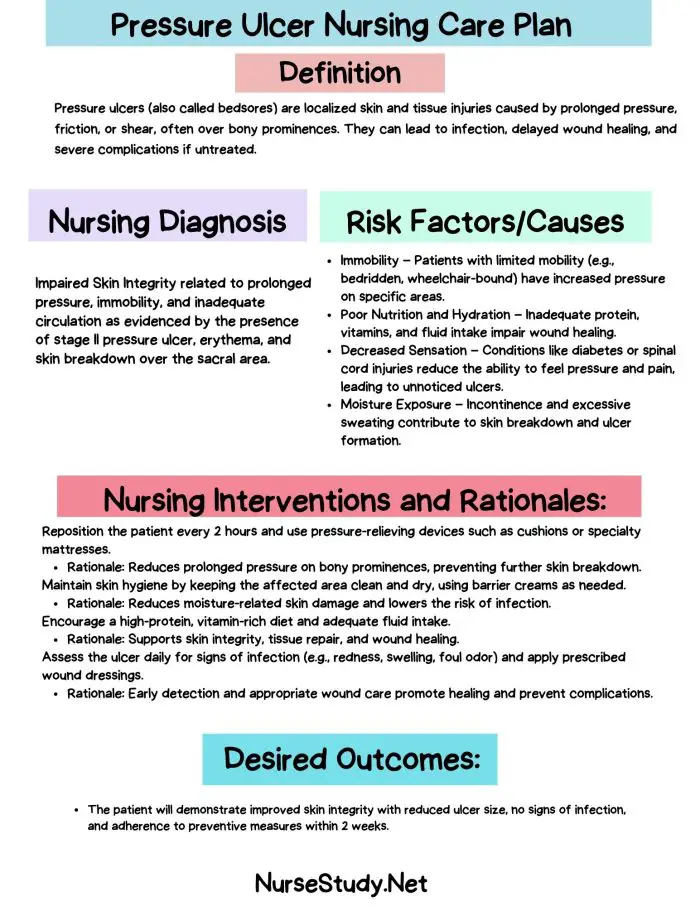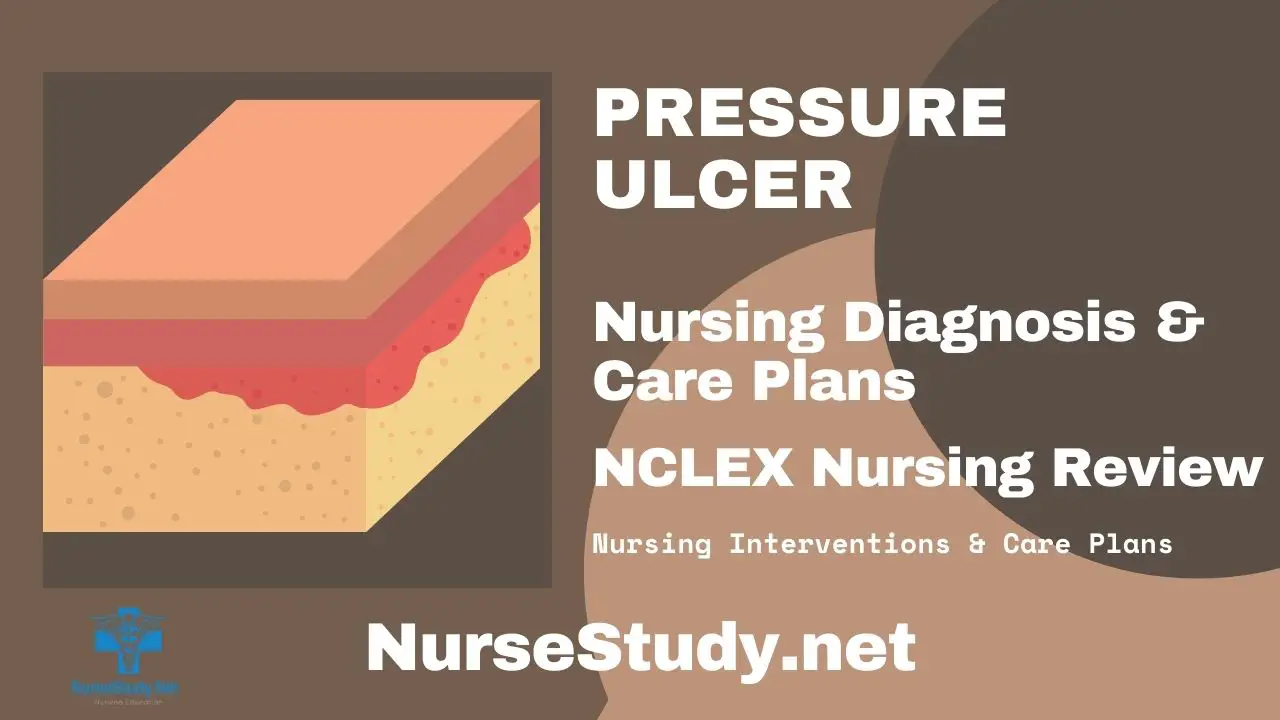Pressure ulcers, also known as bedsores or decubitus ulcers, are localized areas of tissue damage resulting from prolonged pressure on the skin and underlying tissues.
These injuries often occur over bony prominences, ranging from mild redness to severe tissue damage extending into muscle and bone.
Understanding Pressure Ulcers
Pressure ulcers develop when prolonged pressure on the skin reduces blood flow to the area, leading to tissue damage. Factors contributing to pressure ulcer formation include:
- Immobility
- Poor nutrition
- Incontinence
- Reduced sensation
- Chronic conditions (e.g., diabetes, vascular diseases)
- Advanced age
Early identification and intervention are crucial to preventing pressure ulcers and promoting healing in existing cases.
Pressure Ulcer Staging
The National Pressure Ulcer Advisory Panel (NPUAP) has established a staging system to classify pressure ulcers:
- Stage 1: Non-blanchable erythema of intact skin
- Stage 2: Partial-thickness skin loss with exposed dermis
- Stage 3: Full-thickness skin loss
- Stage 4: Full-thickness skin and tissue loss with exposed muscle, tendon, or bone
- Unstageable: Full-thickness skin and tissue loss with slough or eschar
- Deep Tissue Pressure Injury: Persistent non-blanchable deep red, maroon, or purple discoloration
Understanding these stages is crucial for accurate assessment and appropriate intervention planning.
Nursing Process for Pressure Ulcer Management
The nursing process provides a systematic approach to pressure ulcer care:
- Assessment: Conduct thorough skin assessments, identify risk factors, and use validated risk assessment tools (e.g., Braden Scale).
- Diagnosis: Formulate nursing diagnoses based on assessment findings.
- Planning: Develop care plans with specific, measurable goals.
- Implementation: Execute interventions aimed at prevention, treatment, and education.
- Evaluation: Regularly assess the effectiveness of interventions and adjust care plans as needed.
Nursing Care Plans for Pressure Ulcers
Here are five comprehensive nursing care plans addressing common issues related to pressure ulcers:
1. Impaired Skin Integrity
Nursing Diagnosis Statement: Impaired Skin Integrity related to prolonged pressure and immobility as evidenced by stage 2 pressure ulcer on the sacrum.
Related Factors/Causes:
- Prolonged immobility
- Poor nutritional status
- Incontinence
- Reduced sensation
Nursing Interventions and Rationales:
- Perform comprehensive skin assessments every shift.
Rationale: Early detection of skin changes allows for prompt intervention. - Implement a regular turning schedule (every 2 hours minimum).
Rationale: Frequent repositioning reduces pressure on vulnerable areas. - Use pressure-redistribution surfaces (e.g., air mattresses, foam overlays).
Rationale: These surfaces help distribute pressure evenly, reducing the risk of further tissue damage. - Maintain proper nutrition and hydration.
Rationale: Adequate nutrition supports tissue healing and skin integrity. - Keep skin clean and dry, especially in areas prone to moisture.
Rationale: Proper hygiene reduces the risk of skin breakdown and infection.
Desired Outcomes:
- The patient will demonstrate improved skin integrity within two weeks.
- No new pressure ulcers will develop during hospitalization.
2. Risk for Infection
Nursing Diagnosis Statement: Risk for Infection related to a break in skin integrity secondary to pressure ulcer.
Related Factors/Causes:
- Open wound
- Compromised immune system
- Poor nutritional status
- Incontinence
Nursing Interventions and Rationales:
- Practice proper hand hygiene and use personal protective equipment.
Rationale: Reduces the risk of pathogen transmission. - Perform wound care using an aseptic technique as ordered.
Rationale: Proper wound care reduces the risk of infection and promotes healing. - Monitor the wound and surrounding area for signs of infection (e.g., redness, warmth, purulent drainage).
Rationale: Early detection of infection allows for prompt treatment. - Administer antibiotics as prescribed.
Rationale: Systemic antibiotics may be necessary to treat or prevent infection. - Educate patients and caregivers on signs of infection and proper wound care techniques.
Rationale: Empowers patients and caregivers to promptly participate in care and report concerns.
Desired Outcomes:
- The patient will remain free from signs and symptoms of wound infection.
- Patient and caregivers will demonstrate proper wound care techniques.
3. Impaired Physical Mobility
Nursing Diagnosis Statement: Impaired Physical Mobility related to pain and discomfort from pressure ulcer as evidenced by reluctance to move or reposition.
Related Factors/Causes:
- Pain from pressure ulcer
- Fear of exacerbating the wound
- Weakness or fatigue
- Prescribed bed rest
Nursing Interventions and Rationales:
- Assess pain level before and after repositioning.
Rationale: Allows for appropriate pain management and evaluation of interventions. - Administer pain medication as prescribed before repositioning.
Rationale: Preemptive pain management can improve comfort and willingness to move. - Use assistive devices (e.g., trapeze, side rails) to facilitate movement.
Rationale: Promotes independence and reduces strain on caregivers. - Implement a progressive mobility plan as tolerated.
Rationale: Gradual increase in activity can improve overall mobility and reduce complications of immobility. - Provide physical therapy and occupational therapy as ordered.
Rationale: Specialized interventions can improve strength, flexibility, and functional mobility.
Desired Outcomes:
- The patient will demonstrate increased participation in repositioning and mobility activities.
- The patient will report decreased pain associated with movement within 1 week.
4. Imbalanced Nutrition: Less Than Body Requirements
Nursing Diagnosis Statement: Imbalanced Nutrition: Less Than Body Requirements related to increased metabolic demands of wound healing as evidenced by weight loss and poor wound healing.
Related Factors/Causes:
- Increased nutritional needs due to wound healing
- Poor appetite
- Difficulty eating due to positioning
- Chronic illness affecting metabolism
Nursing Interventions and Rationales:
- Assess nutritional status using validated tools (e.g., Mini Nutritional Assessment).
Rationale: Provides baseline data and helps identify specific nutritional deficits. - Collaborate with a dietitian to develop an individualized nutrition plan.
Rationale: Ensures nutritional interventions are tailored to the patient’s specific needs and preferences. - Offer high-protein, high-calorie supplements between meals.
Rationale: Supplements can help meet increased nutritional demands for wound healing. - Monitor daily intake and output, including wound drainage.
Rationale: Helps assess fluid balance and nutritional adequacy. - Assist with feeding as needed and provide a comfortable eating position.
Rationale: Promotes increased intake and reduces the risk of aspiration.
Desired Outcomes:
- The patient will demonstrate improved nutritional status as evidenced by weight gain and improved wound healing within three weeks.
- The patient will consume at least 75% of the meals and supplements provided.
5. Deficient Knowledge
Nursing Diagnosis Statement: Deficient Knowledge related to pressure ulcer prevention and care as evidenced by verbalization of misconceptions about wound care.
Related Factors/Causes:
- Lack of exposure to pressure ulcer education
- Misunderstanding of the importance of preventive measures
- Cognitive limitations
- Language or cultural barriers
Nursing Interventions and Rationales:
- Assess the patient’s and caregiver’s current knowledge of pressure ulcer prevention and care.
Rationale: Identifies knowledge gaps and guides educational interventions. - Provide education on pressure ulcer etiology, risk factors, and prevention strategies.
Rationale: Understanding the causes and prevention of pressure ulcers can improve compliance with preventive measures. - Demonstrate proper skin inspection and care techniques.
Rationale: Hands-on learning can improve retention and skill development. - Offer written materials and visual aids in the patient’s preferred language.
Rationale: Reinforces verbal education and provides a reference for future use. - Encourage questions and provide opportunities for return demonstration.
Rationale: Promotes active learning and allows for clarification of misunderstandings.
Desired Outcomes:
- Patient and caregivers will verbalize understanding of pressure ulcer prevention and care within three days.
- Patient and caregivers will demonstrate proper skin inspection and care techniques before discharge.
Conclusion
Effective management of pressure ulcers requires a comprehensive approach that addresses not only the wound itself but also the underlying factors contributing to its development. By implementing these nursing care plans and staying vigilant in assessment and intervention, healthcare professionals can significantly improve outcomes for patients at risk for or experiencing pressure ulcers.
Remember that each patient is unique, and care plans should be individualized based on specific needs, risk factors, and treatment goals. Regular reassessment and adjustment of care plans are essential to ensure optimal patient outcomes.
References
- National Pressure Ulcer Advisory Panel, European Pressure Ulcer Advisory Panel and Pan Pacific Pressure Injury Alliance. (2019). Prevention and Treatment of Pressure Ulcers/Injuries: Clinical Practice Guideline. The International Guideline.
- Edsberg, L. E., Black, J. M., Goldberg, M., McNichol, L., Moore, L., & Sieggreen, M. (2016). Revised National Pressure Ulcer Advisory Panel Pressure Injury Staging System. Journal of Wound, Ostomy, and Continence Nursing, 43(6), 585-597.
- Haesler, E. (Ed.). (2019). Prevention and Treatment of Pressure Ulcers/Injuries: Quick Reference Guide. European Pressure Ulcer Advisory Panel, National Pressure Injury Advisory Panel, and Pan Pacific Pressure Injury Alliance.
- Doughty, D. B., & McNichol, L. L. (2015). Wound, Ostomy and Continence Nurses Society Core Curriculum: Wound Management. Wolters Kluwer Health.
- Bergstrom, N., Braden, B. J., Laguzza, A., & Holman, V. (1987). The Braden Scale for Predicting Pressure Sore Risk. Nursing Research, 36(4), 205-210.
- Chou, R., Dana, T., Bougatsos, C., Blazina, I., Starmer, A. J., Reitel, K., & Buckley, D. I. (2013). Pressure Ulcer Risk Assessment and Prevention: A Systematic Comparative Effectiveness Review. Annals of Internal Medicine, 159(1), 28-38.
- Wound, Ostomy and Continence Nurses Society. (2016). Guideline for Prevention and Management of Pressure Ulcers (Injuries). Mount Laurel, NJ: Author.
- Cox, J. (2017). Predictors of pressure ulcers in adult critical care patients. American Journal of Critical Care, 26(6), 501-511.
- Coleman, S., Nixon, J., Keen, J., Wilson, L., McGinnis, E., Dealey, C., … & Nelson, E. A. (2014). A new pressure ulcer conceptual framework. Journal of Advanced Nursing, 70(10), 2222-2234.
- Lyder, C. H., & Ayello, E. A. (2008). Pressure Ulcers: A Patient Safety Issue. In R. G. Hughes (Ed.), Patient Safety and Quality: An Evidence-Based Handbook for Nurses. Agency for Healthcare Research and Quality (US).

